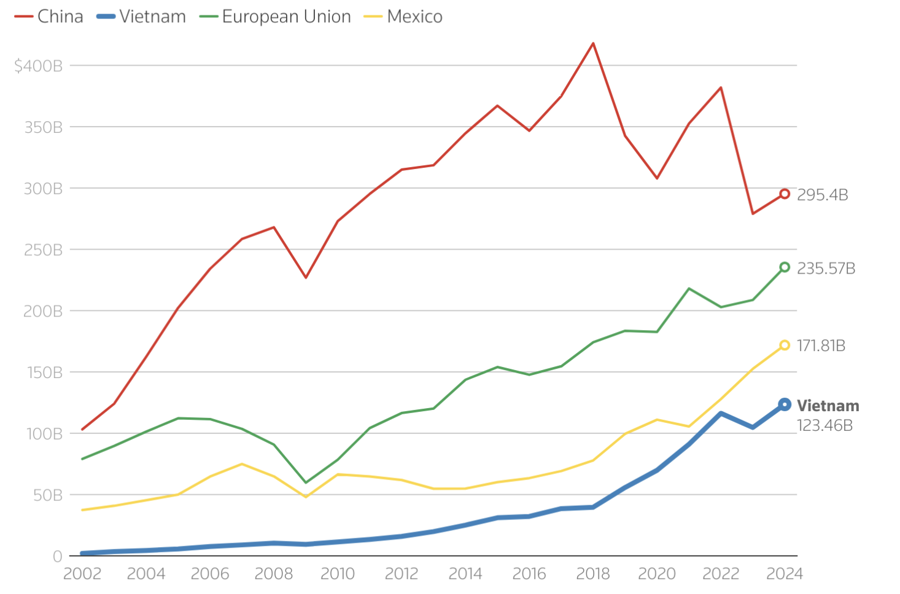The U.S. trade deficit surged in December as imports rose to a record high, amid looming tariff threats that may have prompted businesses to stock up on goods before the tariffs took effect.
According to a report from the U.S. Commerce Department on February 5, the trade deficit jumped 24.7% to $98.4 billion in December, the highest since March 2022, from $78.9 billion in November.
This was the second-highest monthly trade deficit on record for the U.S., and the increase from the previous month was the largest since March 2015.
The report also showed that the U.S. had significant trade deficits with several of its top trading partners, including China, Mexico, and Canada—the three countries that have been targeted by President Donald Trump’s tariffs.
On Monday, Trump delayed the imposition of 25% tariffs on Mexican and Canadian goods by one month. The following day, the additional 10% tariffs on Chinese goods took effect.
While Trump’s primary focus in his first term was addressing the large trade deficits with China, the recent tariff actions are aimed at addressing illegal immigration and drug trafficking concerns. Nonetheless, the sharp increase in the trade deficit in December could bolster arguments in favor of the Trump administration’s protectionist trade policies.
“The jump in imports likely mostly reflects businesses bringing forward imports ahead of the tariffs. This is unlikely to be quickly reversed as tariffs of 25% may still be imposed on Mexico and Canada next month,” said Thomas Ryan, an economist at Capital Economics. “Recent surveys suggest that exports may pick up, but such a large rise in imports implies that the trade deficit will widen further in Q1.”
For the full year 2024, the U.S. trade deficit increased 17% to $918.4 billion, the highest since 2021.
December imports rose 3.5% to an all-time high of $364.9 billion.
Imports of goods increased 4% to $293.1 billion. Imports of industrial supplies and materials rose by $10.8 billion, mainly due to a $9.2 billion increase in imports of finished metal shapes from Switzerland.
This has led some economists to question the notion that advanced ordering ahead of tariffs was the sole reason behind the surge in the trade deficit. “Switzerland is certainly not a country that Trump is considering putting tariffs on. I think this is just temporary growth in imports, meaning there is a good chance the trade deficit will fall sharply in January unless there is a rush to import ahead of the tariffs,” said Stephen Stanley, chief economist at Santander US Capital Markets.
Exports of goods decreased 4.2% to $170.2 billion in December, the largest decline since May 2020.
When considering only goods, the trade deficit in December rose 18.2% from the previous month to a record $123 billion. Adjusting for inflation, the goods trade deficit was $111.9 billion, an increase of 15.4%.
The goods trade deficit with Canada widened by $2.9 billion in December to $7.9 billion.
The goods trade deficit with China narrowed slightly in December but widened to $295.4 billion in 2024 from $279.1 billion in 2023.
The deficit with Mexico narrowed to $15.2 billion in December from $15.4 billion in November.

Vietnam was the fourth-largest trade surplus partner with the U.S., after China, the EU, and Mexico.
Services imports in December rose by $1 billion to a record $71.8 billion, while services exports increased by $0.4 billion to a record $96.3 billion.



![[Photo Essay]: Experts, Managers, and Businesses Unite to Forge a Path Towards Sustainable Green Industry](https://xe.today/wp-content/uploads/2025/07/z678592918-218x150.jpg)


![[Photo Essay]: Experts, Managers, and Businesses Unite to Forge a Path Towards Sustainable Green Industry](https://xe.today/wp-content/uploads/2025/07/z678592918-150x150.jpg)


![[Photo Essay]: Experts, Managers, and Businesses Unite to Forge a Path Towards Sustainable Green Industry](https://xe.today/wp-content/uploads/2025/07/z678592918-100x70.jpg)






